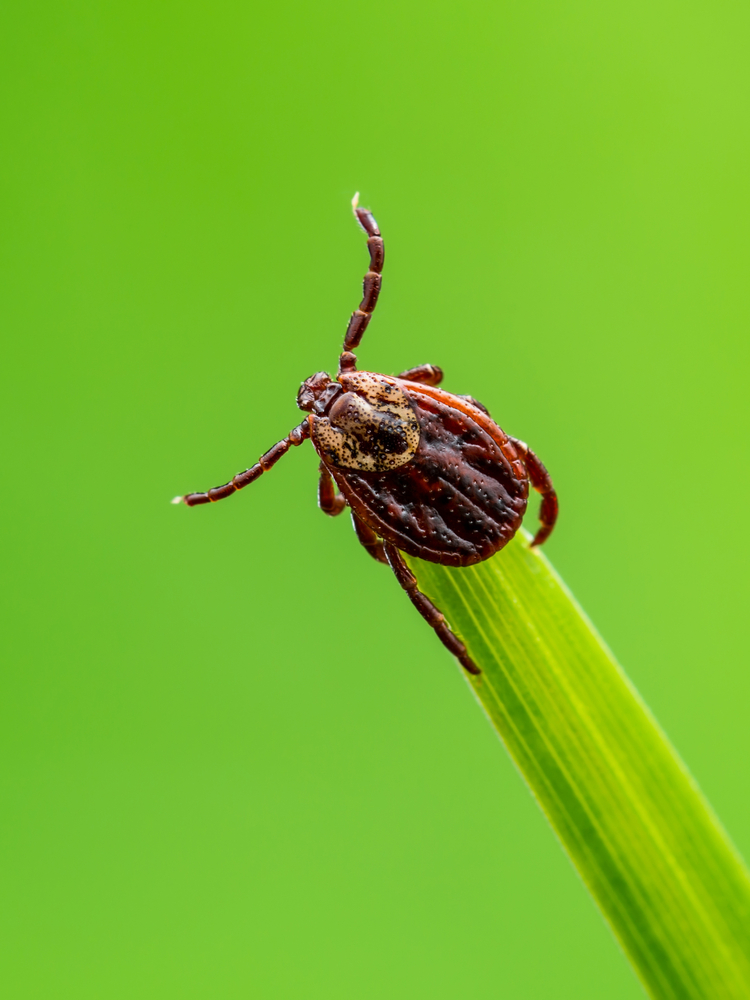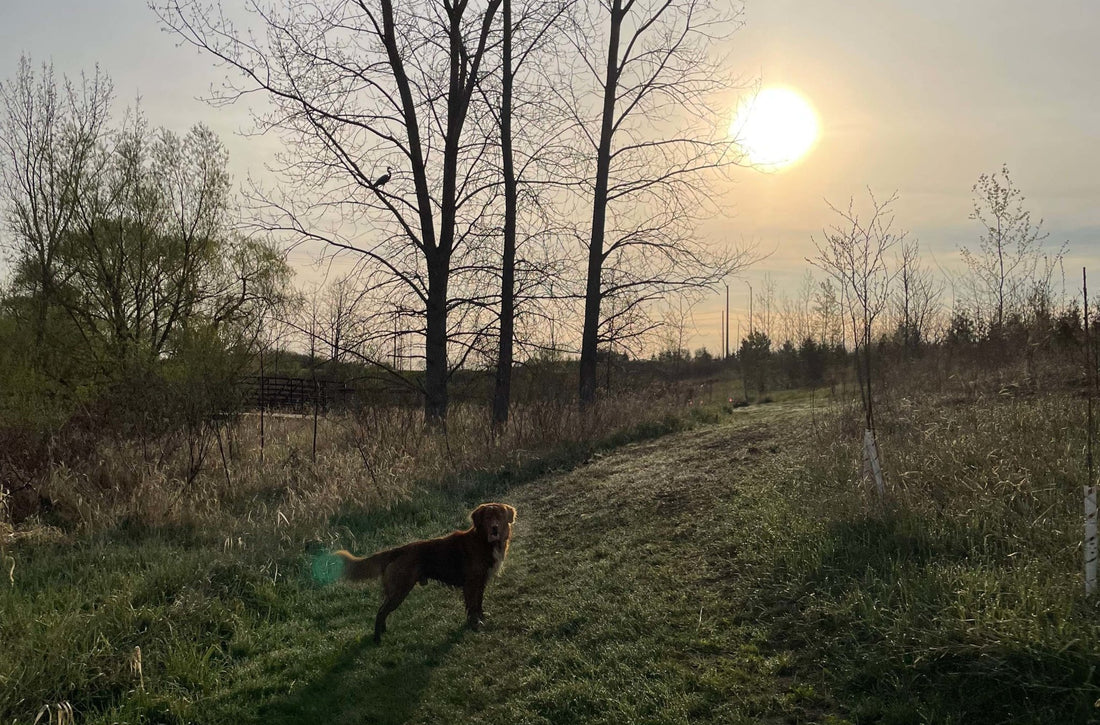I think we can all settle into the idea that ticks are here to stay in Ontario. We've been spoiled for a long time. By now, we should all see the privileged position we've been in until recent years.
Having been involved in field training since I brought home my first Toller in 2001, I've watched ticks go from 'never' to 'occasional' to 'often' to 'likely every outing'.
When COVID took our activities away, it became very clear that I could live without dog shows, competitions, and organized indoor events. It was clear early on that while I missed those things, I wasn't physically or mentally hurt by their absence. The same could never be true of hikes outside of the concrete jungle with a Toller or two in tow! My mental and physical health takes a big hit when I don't have a chance to connect with nature and the bush.
If I'm not willing to let a pandemic keep me from hiking with my dogs, there's no chance I'm going to let a BUG do so.
3 years ago, I recorded myself removing a tick from Ned's neck. When I look back at that video and hear my voice quiver, I realize how much I've learned about preventing ticks from travelling home with me, either on Ned or myself. I thought it was high time I shared some of the knowledge I've gained through my experiences.
Preventatives
There are MANY options for tick prevention ranging from natural remedies, like essential oils, to pesticide interventions. Talk to your vet about the right kind of preventatives for you and your dog, but also - talk to people in your communities. Talk to breeders and owners of the same dog breed. There are intolerances that exist in certain breeds to some chemicals. The full picture can't be seen by reading the box alone. Do your reading and your research and choose a safe and effective option for your dog.
After you've done all of the reading and all of the research, know that there will still be ticks if you venture into high risk spaces. I use a topical chemical containing Permethrin with Ned. I also spray us both liberally with Picaradin spray before heading out on each hike. Despite being diligent with the application of both, I still find ticks on my tick checks. Ned has an incredibly thick coat and he's at the top of the weight range for the product. When I find one tick, I remind myself that likely there would have been 10 more. Nothing is perfect. I do keep copious notes so I can determine for myself if Permethrin is becoming less effective at killing ticks over time.
It's worth noting that Permethrin is toxic to cats. If you have cats in the home, it may not be the right product for you.
Tips to Avoid Ticks Altogether!

The best way to avoid Lyme, Rocky Mountain Spotted Fever and a whole bunch of other nasty diseases caused by interaction with ticks that might carry that bacteria is to avoid ticks altogether. While likely impossible, it's worth a try!! If you're a city walker, stick to the side walks (particularly during the Spring and Fall months). Remove debris piles, like the ones that collect along fences, and keep your grass cut relatively short.
If you're a bushwalker, stay in the middle of the trail whenever possible! Ticks don't jump or fly. They grab and walk onto their host. They are equipped with opposable claws on their "prospecting arms" (the ones that look like antennas). They use these arms to grab a host as it walks by. They hang out in bushes and long grass along the sides of the trail and wait to sense your carbon dioxide (or your dog or a deer or.... they're NOT picky - they just want a bloodmeal!)
If you avoid walking close to the sides of the path where they are prospecting, they can't reach you!!!! If you happen to brush against the side of the path, do a quick visual check of your sleeves and pants. Wearing bright, solid-coloured clothing will help you spot them quickly. Paisley is not a good option for walks on trails where ticks are plentiful.... Take things one step further by purchasing clothing pre-treated with Permethrin!
Other tips:
- Tuck in your socks (we won't tell the cool kids)
- Wear a hat - especially if you have a lot of hair that would be easy for a tick to hide in
- Do quick visual checks of both you and your dog often. In my experience, if you think you saw something, you probably did - go digging right away. In most cases, a tick must be attached for at least 24 hours to transmit bacteria. The quicker you remove them, the less risk to all
- Use multiple options for Tick control (be sure to check safety guidelines). Just like in stocks, it's good to diversify! Note that DEET is toxic for dogs, but an alternative like Picaridin can be used in its place. It's been proven just as effective as DEET in many studies and is safe to use on dogs. I spray it all over, paying close attention to Ned's stomach and legs. I then rub it on his ears, head and muzzle, since those are the things that make contact with the bush first, I'm hopeful that any ticks waiting for lunch are annoyed and move away rather than toward
Tick Checks
- Take a thorough look over your dog at the end of every outing. Look through the coat visually (watch for 'moving shadows'). Using a lint roller to back brush through the coat will often catch some ticks and it can be done fairly quickly. They're also VERY handy to catch small ticks on OUR clothes before we get back into the car or house.
- Back brush or use a hairdryer to check for more! Some people can feel the tiniest tick on their dogs, even heavily-coated ones. I don't have that talent.... One day when feeling fairly confident Ned would be tick-free after a thorough check, I turned the forced air dryer on and found 7 ticks in various stages of the 'bite-and-maybe-die' cycle.
- Take your hiking clothes off and put them straight into the dryer! 10 minutes on high heat will kill a tick. If you must wash your clothes first, do so using the hot cycle. Ticks can survive a cold wash cycle with ease.

Tick Removal
This is where I start shouting!!!
DO NOT TWIST!!
DO NOT BURN!!
DO NOT RUB VASELINE!!
Okay, you've likely heard of many of these methods from many different places. Maybe even from a vet or a doctor. I don't often claim to be right in a mass argument like this, but I stand confidently here and sing it!! If you look to the authorities on the subject (Government websites, Tick researchers and experts, well-researched documentaries and articles, and the list goes on...), they all say DO NOT TWIST! So don't twist the tick! You risk leaving the mouthpiece, full of barbs in the host.
Other methods like burning and rubbing Vaseline or cotton balls on the ticks will work to have the tick let go. They sure do! The reason the tick releases its grip is that these methods cause them to regurgitate. While I'm not ashamed of feeling glee at the idea of making a tick sick, I do not want them to spit their toxins back into me or my dog as they let go. That is what those methods end up doing.
To remove a tick, grip firmly as close to the mouth as possible and pull straight up with steady pressure until the tick lets go. That's all. Do not twist or jerk the tick!
Not all ticks are created equally! There are 850 species of ticks in the world and most are pretty hearty creatures that don't give into death easily. Be sure to do your homework to learn about the ticks, and the associated troubles in your area.
Ticks are most active in the Spring and Fall months but can be up and at it anytime through the year. Be ever vigilant and leave them in the bush!

